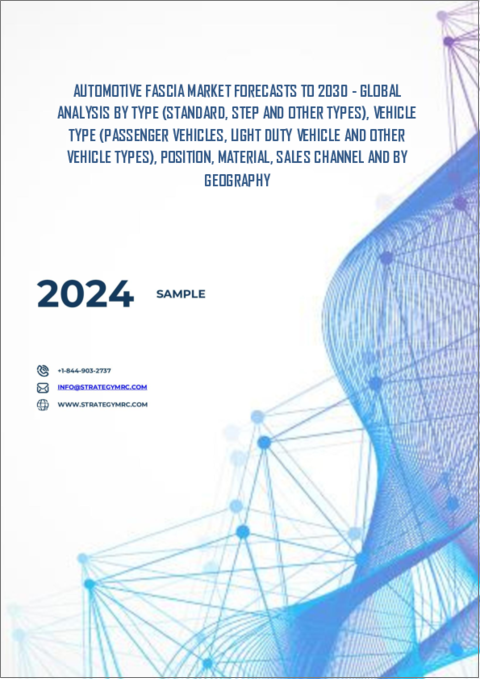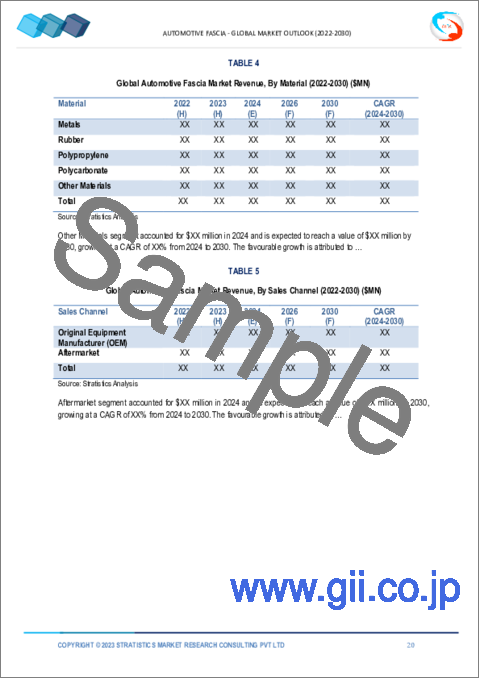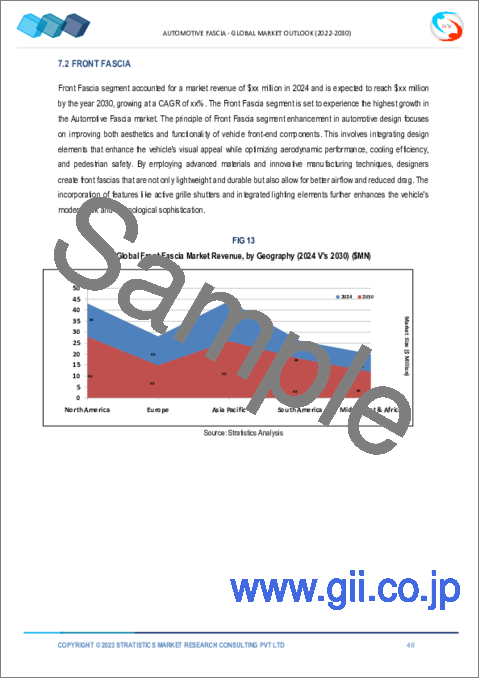|
|
市場調査レポート
商品コード
1447076
自動車用フェイシアの2030年までの世界市場予測: タイプ別、車種別、位置別、材料別、販売チャネル別、地域別Automotive Fascia Market Forecasts to 2030 - Global Analysis By Type (Standard, Step and Other Types), Vehicle Type (Passenger Vehicles, Light Duty Vehicle and Other Vehicle Types), Position, Material, Sales Channel and By Geography |
||||||
カスタマイズ可能
|
|||||||
| 自動車用フェイシアの2030年までの世界市場予測: タイプ別、車種別、位置別、材料別、販売チャネル別、地域別 |
|
出版日: 2024年03月03日
発行: Stratistics Market Research Consulting
ページ情報: 英文 200+ Pages
納期: 2~3営業日
|
全表示
- 概要
- 図表
- 目次
Stratistics MRCによると、自動車用フェイシアの世界市場は2023年に232億米ドルを占め、予測期間中にCAGR 8.90%で成長し、2030年には421億米ドルに達すると予測されています。
自動車の「フロントエンド」または「フェイス」と呼ばれる自動車用フェイシアには、美的外観と機能性に寄与する様々な部品が含まれます。一般的には、グリル、ヘッドライト、バンパー、その他車両前部に位置するスタイリング要素が含まれます。美観だけでなく、フェイシャは、衝突時に車両のフロントエンドを保護したり、エンジンを冷却するための空気の流れを提供したりするなど、実用的な目的も果たします。自動車メーカーは、ブランドのアイデンティティとデザイン言語を反映させながら、安全規制と空力特性を考慮し、フェイシアを慎重にデザインします。フェイシアはますます複雑化し、アダプティブ・ライティング・システム、運転支援システム用センサー、さらには統合されたコネクティビティ要素などの機能が組み込まれています。
インド自動車工業会(SIAM)によると、2019年の乗用車販売台数は330万台だった。国際自動車製造者機構(OICA)によると、中国は2020年8月に220万台の自動車を出荷しました。
高級車デザインの台頭
高級車デザインの台頭は、自動車用フェイシア市場に大きな影響を与えます。消費者がエレガントで人目を引く自動車用フェイシアを求める傾向が強まる中、自動車メーカーはフェイシアを含む視覚的に魅力的なフロントエンドコンポーネントの作成を優先しています。高級車は洗練された美的感覚に優れたデザインを特徴とすることが多く、よく練られたスタイリッシュなフェイシア部品の需要を促進しています。この動向は、パーソナライズされた個性的な車への嗜好の高まりと一致しており、フェイシアは全体的な外観を向上させる上で重要な役割を果たしています。その結果、自動車用フェイシア産業は拡大を続け、現代の自動車における安全性と美観の両方に対する欲求に応えています。
高い製造コスト
製造コストが高いことは、複雑な設計要件と最新のフェイシア・コンポーネントに必要な高度な材料が製造費用を増加させるため、大きな抑制要因となっています。厳しい品質基準と規制遵守がコスト負担に拍車をかけています。製造に必要な自動化や特殊な設備は、さらに費用を増大させる。さらに、特に高級プラスチックや複合材料の原材料価格の変動が、製造コスト全体を押し上げています。
技術統合
自動車用フェイシア市場は、主に自動車の美観と機能性の両方において重要な役割を担っているため、技術統合の大きな機会を提供しています。AR(拡張現実)ディスプレイ、ADAS(先進運転支援システム)用統合センサー、スマート照明ソリューションなどの先進技術を組み込むことで、メーカーは自動車業界に革命を起こすことができます。これらの統合により、 促進要因と同乗者の安全性、利便性、ユーザーエクスペリエンスが向上します。さらに、5GコネクティビティやV2X(Vehicle-to-Everything)通信のようなコネクティビティ機能は、自動車用フェイシアの機能性をさらに高めることができます。
知的財産
知的財産リスクは重大な脅威となります。これらのリスクには、フェイシア・システムに組み込まれた設計要素または技術革新に関連する特許侵害クレームが含まれます。競合他社は、特定の設計機能に関する所有権を主張する可能性があり、法的紛争や費用のかかる訴訟に発展する可能性があります。さらに、偽造や独自のデザインの無断複製のリスクは、ブランドの評判や市場シェアを損なう可能性があります。この分野で事業を展開する企業は、自社のイノベーションを保護し、侵害のリスクを軽減するために、強固な知的財産保護戦略に投資する必要があります。
COVID-19の影響:
当初、広範なロックダウンと経済の不確実性が自動車販売の急減につながり、自動車用ファスナーの需要に影響を与えました。サプライチェーンの混乱や工場の閉鎖がさらに状況を悪化させ、生産と流通に遅れが生じました。さらに、生活必需品や遠隔地への仕事への消費者の優先順位のシフトは、自動車への裁量的支出を減らし、市場の回復に影響を与えました。景気が徐々に回復し、自動車生産が再開されるにつれて、市場は旺盛な需要と政府の景気刺激策によって回復の兆しを見せた。しかし、半導体不足のような継続的な課題は、自動車用フェイシア市場の完全な回復軌道に不確実性をもたらし続けています。
予測期間中、小型車セグメントが最大となる見込み
自動車用フェイシア市場における小型車セグメントは、フェイシアコンポーネント用の軽量かつ耐久性のある材料の開拓を可能にした技術の継続的な進歩により、力強い成長を遂げています。美的なカスタマイズや洗練されたデザインに対する消費者の需要の高まりが、このセグメントにおけるメーカーの技術革新を促し、さまざまな嗜好に応える幅広い選択肢を提供しています。自動車の安全性と排ガスに関する厳しい規制が、自動車メーカーにフェイシア用の軽量材料への投資を促し、このセグメントの成長に寄与しています。
予測期間中にCAGRが最も高くなると予想される金属セグメント
金属セグメントは、アルミニウムやスチールなどの金属が提供する優れた強度と耐久性により、顕著な成長を遂げており、自動車の保護を強化しています。金属製造技術の進歩により、コスト効率の高い製造プロセスが実現し、自動車メーカーにとって魅力的なものとなっています。さらに、金属は複雑なデザインとスタイリングのオプションを可能にし、消費者の美的嗜好に応えます。さらに、燃費を向上させるために自動車の軽量化がますます重視されるようになっており、金属はその高い強度対重量比により説得力のあるソリューションを提供しています。
最大のシェアを持つ地域
北米地域は、高度な車両美観と安全機能のために自動車用フェイシア・システムの採用が増加しているため、市場で大きな成長を経験しています。歩行者の安全性と燃費効率に関する厳しい規制により、自動車メーカーによる革新的なフェイシア・ソリューションの統合が必要となっています。さらに、同地域における乗用車と商用車の生産と販売の増加が、自動車用外板部品の需要を押し上げています。さらに、センサー、カメラ、先進材料の自動車用フェイシアデザインへの統合といった技術的進歩が、市場の成長をさらに促進しています。
CAGRが最も高い地域:
アジア太平洋地域は、可処分所得の増加と都市化によって市場が大きく成長し、自動車需要の高まりが自動車用フェイシア部品の必要性を高めています。中国やインドなどでは中間所得層が急増し、自動車の所有率が高まっているため、市場の成長がさらに加速しています。さらに、同地域の自動車製造業は、政府の好意的な政策と投資に支えられて増加し、外板部品を必要とする自動車の生産台数を伸ばしています。さらに、自動車の安全性に関する意識の高まりと、高度な安全機能の使用を義務付ける規制が、アジア太平洋地域における先進的なフェイシア・システムの採用を促進しています。
無料カスタマイズの提供
本レポートをご購読のお客様には、以下の無料カスタマイズオプションのいずれかを提供いたします:
- 企業プロファイル
- 追加市場プレイヤーの包括的プロファイリング(3社まで)
- 主要企業のSWOT分析(3社まで)
- 地域セグメンテーション
- 顧客の関心に応じた主要国の市場推計・予測・CAGR(注:フィージビリティチェックによる)
- 競合ベンチマーキング
- 製品ポートフォリオ、地理的プレゼンス、戦略的提携に基づく主要企業のベンチマーキング
目次
第1章 エグゼクティブサマリー
第2章 序文
- アクリロニトリルブタジエンスチレン(ABS)トラクト
- ステークホルダー
- 調査範囲
- 調査手法
- データマイニング
- データ分析
- データ検証
- 調査アプローチ
- 調査ソース
- 1次調査ソース
- 2次調査ソース
- 前提条件
第3章 市場動向分析
- 促進要因
- 抑制要因
- 機会
- 脅威
- 新興市場
- 新型コロナウイルス感染症(COVID-19)の影響
第4章 ポーターのファイブフォース分析
- 供給企業の交渉力
- 買い手の交渉力
- 代替品の脅威
- 新規参入業者の脅威
- 競争企業間の敵対関係
第5章 世界の自動車用フェイシア市場:タイプ別
- 標準
- ステップ
- その他のタイプ
第6章 世界の自動車用フェイシア市場:車種別
- 乗用車
- ハッチバック
- 実用車
- セダン
- 小型車両
- バスと長距離バス
- 中型および大型トラック
- その他の車種
第7章 世界の自動車用フェイシア市場:位置別
- フロントフェイシア
- リアフェイシア
第8章 世界の自動車用フェイシア市場:材料別
- 金属
- 鋼鉄
- アルミニウム
- アクリロニトリルブタジエンスチレン(ABS)
- ゴム
- ポリプロピレン
- ポリカーボネート
- その他の素材
第9章 世界の自動車用フェイシア市場:販売チャネル別
- 相手先商標製品製造業者(OEM)
- アフターマーケット
第10章 世界の自動車用フェイシア市場:地域別
- 北米
- 米国
- カナダ
- メキシコ
- 欧州
- ドイツ
- 英国
- イタリア
- フランス
- スペイン
- その他欧州
- アジア太平洋地域
- 日本
- 中国
- インド
- オーストラリア
- ニュージーランド
- 韓国
- その他アジア太平洋地域
- 南米
- アルゼンチン
- ブラジル
- チリ
- その他南米
- 中東とアフリカ
- サウジアラビア
- アラブ首長国連邦
- カタール
- 南アフリカ
- その他中東とアフリカ
第11章 主な発展
- 契約、パートナーシップ、コラボレーション、合弁事業
- 買収と合併
- 新製品の発売
- 事業拡大
- その他の主要戦略
第12章 企業プロファイル
- Aisin Corporation
- Chiyoda Manufacturing
- Dakkota Integrated System LLC
- Dongfeng Electronic Technology Co. Ltd.
- Eakas Corporation
- Flex-N-Gate Corporation
- Gestamp Automocion
- Guardian Industries
- Inhance Technologies
- Magna International
- MRC Manufacturing
- Plastic Omnium
- Revere Plastics System
- Samvardhana Motherson
- Sanko GOSEI
- Toyoda Gosei
List of Tables
- Table 1 Global Automotive Fascia Market Outlook, By Region (2021-2030) ($MN)
- Table 2 Global Automotive Fascia Market Outlook, By Type (2021-2030) ($MN)
- Table 3 Global Automotive Fascia Market Outlook, By Standard (2021-2030) ($MN)
- Table 4 Global Automotive Fascia Market Outlook, By Step (2021-2030) ($MN)
- Table 5 Global Automotive Fascia Market Outlook, By Other Types (2021-2030) ($MN)
- Table 6 Global Automotive Fascia Market Outlook, By Vehicle Type (2021-2030) ($MN)
- Table 7 Global Automotive Fascia Market Outlook, By Passenger Vehicles (2021-2030) ($MN)
- Table 8 Global Automotive Fascia Market Outlook, By Hatchback (2021-2030) ($MN)
- Table 9 Global Automotive Fascia Market Outlook, By Utility Vehicle (2021-2030) ($MN)
- Table 10 Global Automotive Fascia Market Outlook, By Sedan (2021-2030) ($MN)
- Table 11 Global Automotive Fascia Market Outlook, By Light Duty Vehicle (2021-2030) ($MN)
- Table 12 Global Automotive Fascia Market Outlook, By Bus & Coaches (2021-2030) ($MN)
- Table 13 Global Automotive Fascia Market Outlook, By Medium & Heavy Duty Trucks (2021-2030) ($MN)
- Table 14 Global Automotive Fascia Market Outlook, By Other Vehicle Types (2021-2030) ($MN)
- Table 15 Global Automotive Fascia Market Outlook, By Position (2021-2030) ($MN)
- Table 16 Global Automotive Fascia Market Outlook, By Front Fascia (2021-2030) ($MN)
- Table 17 Global Automotive Fascia Market Outlook, By Rear Fascia (2021-2030) ($MN)
- Table 18 Global Automotive Fascia Market Outlook, By Material (2021-2030) ($MN)
- Table 19 Global Automotive Fascia Market Outlook, By Metals (2021-2030) ($MN)
- Table 20 Global Automotive Fascia Market Outlook, By Steel (2021-2030) ($MN)
- Table 21 Global Automotive Fascia Market Outlook, By Aluminium (2021-2030) ($MN)
- Table 22 Global Automotive Fascia Market Outlook, By Acrylonitrile butadiene styrene (ABS) (2021-2030) ($MN)
- Table 23 Global Automotive Fascia Market Outlook, By Rubber (2021-2030) ($MN)
- Table 24 Global Automotive Fascia Market Outlook, By Polypropylene (2021-2030) ($MN)
- Table 25 Global Automotive Fascia Market Outlook, By Polycarbonate (2021-2030) ($MN)
- Table 26 Global Automotive Fascia Market Outlook, By Other Materials (2021-2030) ($MN)
- Table 27 Global Automotive Fascia Market Outlook, By Sales Channel (2021-2030) ($MN)
- Table 28 Global Automotive Fascia Market Outlook, By Original Equipment Manufacturer (OEM) (2021-2030) ($MN)
- Table 29 Global Automotive Fascia Market Outlook, By Aftermarket (2021-2030) ($MN)
Note: Tables for North America, Europe, APAC, South America, and Middle East & Africa Regions are also represented in the same manner as above.
According to Stratistics MRC, the Global Automotive Fascia Market is accounted for $23.20 billion in 2023 and is expected to reach $42.10 billion by 2030 growing at a CAGR of 8.90% during the forecast period. The automotive fascia, often referred to simply as the "front end" or "face" of a vehicle, encompasses various components that contribute to its aesthetic appearance and functionality. It typically includes the grille, headlights, bumper, and other styling elements situated at the front of the vehicle. Beyond aesthetics, the fascia also serves practical purposes, such as protecting the vehicle's front end in the event of a collision and providing airflow to cool the engine. Automakers carefully design the fascia to reflect the brand's identity and design language while adhering to safety regulations and aerodynamic considerations. The fascia has become increasingly complex, incorporating features like adaptive lighting systems, sensors for driver-assistance systems, and even integrated connectivity elements.
According to the Society of Indian Automobile Manufacturers (SIAM) the sale of passenger vehicles were 3.3 million units in 2019. According to Organization Internationale des Constructeurs d'Automobiles (OICA) china shipped 2.2 million units of automotive sales in August 2020.
Market Dynamics:
Driver:
Rise of luxury vehicle design
The rise of luxury vehicle design significantly influences the automotive fascia market. As consumers increasingly seek elegant and eye-catching vehicle exteriors, automakers prioritize creating visually appealing front-end components, including fascias. Luxury vehicles often feature sophisticated and aesthetically pleasing designs, driving demand for well-crafted and stylish fascia components. This trend aligns with the growing preference for personalized and distinctive cars, where the fascia plays a crucial role in enhancing the overall appearance. As a result, the automotive fascia industry continues to expand, catering to the desire for both safety and aesthetics in modern vehicles.
Restraint:
High manufacturing costs
High manufacturing costs act as a significant restraint due to the intricate design requirements and advanced materials necessary for modern fascia components increase production expenses. Stringent quality standards and regulatory compliance add to the cost burden. Automation and specialized equipment needed for manufacturing further escalate expenses. Moreover, fluctuating raw material prices, especially for high-grade plastics and composites, contribute to the overall manufacturing cost.
Opportunity:
Technological integration
The automotive fascia market presents a significant opportunity for technological integration, primarily due to its critical role in both the aesthetics and functionality of vehicles. By incorporating advanced technologies such as augmented reality (AR) displays, integrated sensors for enhanced driver assistance systems, and smart lighting solutions, manufacturers can revolutionize the automotive industry. These integrations can offer improved safety, convenience, and user experience for drivers and passengers. Additionally, connectivity features like 5G connectivity and vehicle-to-everything (V2X) communication can further enhance the functionality of the automotive fascia.
Threat:
Intellectual property
Intellectual property risks pose significant threats. These risks include patent infringement claims related to design elements or technological innovations embedded within the fascia systems. Competitors may assert ownership over specific design features, potentially leading to legal disputes and costly litigation. Additionally, the risk of counterfeiting and unauthorized replication of proprietary designs can undermine brand reputation and market share. Companies operating in this space must invest in robust IP protection strategies to safeguard their innovations and mitigate the risk of infringement.
Covid-19 Impact:
Initially, widespread lockdowns and economic uncertainties led to a sharp decline in vehicle sales, affecting the demand for automotive fascias. Supply chain disruptions and factory closures further exacerbated the situation, causing delays in production and distribution. Moreover, shifts in consumer priorities towards essential goods and remote work reduced discretionary spending on automobiles, impacting market recovery. As economies gradually reopened and automotive production resumed, the market showed signs of recovery, driven by pent-up demand and government stimulus measures. However, ongoing challenges such as semiconductor shortages continue to pose uncertainties for the automotive fascia market's full recovery trajectory.
The light-duty vehicle segment is expected to be the largest during the forecast period
The light-duty vehicle segment within the automotive fascia market has experienced robust growth due to ongoing advancements in technology that have enabled the development of lighter yet durable materials for fascia components. Increasing consumer demand for aesthetic customization and sleek designs has driven manufacturers to innovate in this segment, offering a wide range of options to cater to varying preferences. Stringent regulations concerning vehicle safety and emissions have prompted automakers to invest in lightweight materials for fascia, contributing to the segment's growth.
The metals segment is expected to have the highest CAGR during the forecast period
The metals segment is experiencing notable growth due to superior strength and durability offered by metals such as aluminum and steel, providing enhanced protection for vehicles. Advancements in metal manufacturing technologies have led to cost-effective production processes, making them more appealing to automakers. Moreover, metals allow for intricate designs and styling options, catering to the aesthetic preferences of consumers. Furthermore, with an increasing emphasis on light weighting vehicles to improve fuel efficiency, metals offer a compelling solution due to their high strength-to-weight ratios.
Region with largest share:
The North American region has experienced significant growth in the market because of the rising adoption of automotive fascia systems for advanced vehicle aesthetics and safety features. The stringent regulations pertaining to pedestrian safety and fuel efficiency have necessitated the integration of innovative fascia solutions by automotive manufacturers. Moreover, the increasing production and sales of passenger and commercial vehicles in the region have boosted the demand for automotive fascia components. Furthermore, technological advancements such as the integration of sensors, cameras, and advanced materials in fascia designs have further fueled market growth.
Region with highest CAGR:
The Asia-Pacific region has experienced significant growth in the market due to growing disposable incomes and urbanization, leading to higher demand for vehicles driving the need for automotive fascia components. A burgeoning middle class in countries like China and India has boosted vehicle ownership, further propelling market growth. Moreover, the region's increasing automotive manufacturing sector, supported by favourable government policies and investments, has increased the production of vehicles requiring fascia components. Additionally, the growing awareness regarding vehicle safety and regulations mandating the use of advanced safety features have driven the adoption of advanced fascia systems in the Asia-Pacific region.
Key players in the market
Some of the key players in Automotive Fascia market include Aisin Corporation, Chiyoda Manufacturing, Dakkota Integrated System LLC, Dongfeng Electronic Technology Co. Ltd., Eakas Corporation, Flex-N-Gate Corporation, Gestamp Automocion, Guardian Industries, Inhance Technologies, Magna International, MRC Manufacturing, Plastic Omnium, Revere Plastics System, Samvardhana Motherson , Sanko GOSEI and Toyoda Gosei.
Key Developments:
In January 2024, Spain-based automotive components manufacturer Gestamp has announced a multi-year EU-funded research project with two local 5G/IoT specialists to develop a new "operations model" for private 5G and industrial IoT to enable the virtual management of plant operations in the automotive sector.
In January 2024, Samvardhana Motherson International Ltd announced that its subsidiary Samvardhana Motherson Innovative Solutions entered into agreements with BIEL Crystal (Singapore) Pvt Ltd. These multiple pacts include a Securities Subscription Agreement, Shareholders Agreement and Technology Support Agreement, collectively referred to as "Definitive Agreements".
Types Covered:
- Standard
- Step
- Other Types
Vehicle Types Covered:
- Passenger Vehicles
- Light Duty Vehicle
- Bus & Coaches
- Medium & Heavy Duty Trucks
- Other Vehicle Types
Positions Covered:
- Front Fascia
- Rear Fascia
Materials Covered:
- Metals
- Acrylonitrile butadiene styrene (ABS)
- Rubber
- Polypropylene
- Polycarbonate
- Other Materials
Sales Channels Covered:
- Original Equipment Manufacturer (OEM)
- Aftermarket
Regions Covered:
- North America
- US
- Canada
- Mexico
- Europe
- Germany
- UK
- Italy
- France
- Spain
- Rest of Europe
- Asia Pacific
- Japan
- China
- India
- Australia
- New Zealand
- South Korea
- Rest of Asia Pacific
- South America
- Argentina
- Brazil
- Chile
- Rest of South America
- Middle East & Africa
- Saudi Arabia
- UAE
- Qatar
- South Africa
- Rest of Middle East & Africa
What our report offers:
- Market share assessments for the regional and country-level segments
- Strategic recommendations for the new entrants
- Covers Market data for the years 2021, 2022, 2023, 2026, and 2030
- Market Trends (Drivers, Constraints, Opportunities, Threats, Challenges, Investment Opportunities, and recommendations)
- Strategic recommendations in key business segments based on the market estimations
- Competitive landscaping mapping the key common trends
- Company profiling with detailed strategies, financials, and recent developments
- Supply chain trends mapping the latest technological advancements
Free Customization Offerings:
All the customers of this report will be entitled to receive one of the following free customization options:
- Company Profiling
- Comprehensive profiling of additional market players (up to 3)
- SWOT Analysis of key players (up to 3)
- Regional Segmentation
- Market estimations, Forecasts and CAGR of any prominent country as per the client's interest (Note: Depends on feasibility check)
- Competitive Benchmarking
- Benchmarking of key players based on product portfolio, geographical presence, and strategic alliances
Table of Contents
1 Executive Summary
2 Preface
- 2.1 Acrylonitrile butadiene styrene (ABS)tract
- 2.2 Stake Holders
- 2.3 Research Scope
- 2.4 Research Methodology
- 2.4.1 Data Mining
- 2.4.2 Data Analysis
- 2.4.3 Data Validation
- 2.4.4 Research Approach
- 2.5 Research Sources
- 2.5.1 Primary Research Sources
- 2.5.2 Secondary Research Sources
- 2.5.3 Assumptions
3 Market Trend Analysis
- 3.1 Introduction
- 3.2 Drivers
- 3.3 Restraints
- 3.4 Opportunities
- 3.5 Threats
- 3.6 Emerging Markets
- 3.7 Impact of Covid-19
4 Porters Five Force Analysis
- 4.1 Bargaining power of suppliers
- 4.2 Bargaining power of buyers
- 4.3 Threat of substitutes
- 4.4 Threat of new entrants
- 4.5 Competitive rivalry
5 Global Automotive Fascia Market, By Type
- 5.1 Introduction
- 5.2 Standard
- 5.3 Step
- 5.4 Other Types
6 Global Automotive Fascia Market, By Vehicle Type
- 6.1 Introduction
- 6.2 Passenger Vehicles
- 6.2.1 Hatchback
- 6.2.2 Utility Vehicle
- 6.2.3 Sedan
- 6.3 Light Duty Vehicle
- 6.4 Bus & Coaches
- 6.5 Medium & Heavy Duty Trucks
- 6.6 Other Vehicle Types
7 Global Automotive Fascia Market, By Position
- 7.1 Introduction
- 7.2 Front Fascia
- 7.3 Rear Fascia
8 Global Automotive Fascia Market, By Material
- 8.1 Introduction
- 8.2 Metals
- 8.2.1 Steel
- 8.2.2 Aluminium
- 8.3 Acrylonitrile butadiene styrene (ABS)
- 8.4 Rubber
- 8.5 Polypropylene
- 8.6 Polycarbonate
- 8.7 Other Materials
9 Global Automotive Fascia Market, By Sales Channel
- 9.1 Introduction
- 9.2 Original Equipment Manufacturer (OEM)
- 9.3 Aftermarket
10 Global Automotive Fascia Market, By Geography
- 10.1 Introduction
- 10.2 North America
- 10.2.1 US
- 10.2.2 Canada
- 10.2.3 Mexico
- 10.3 Europe
- 10.3.1 Germany
- 10.3.2 UK
- 10.3.3 Italy
- 10.3.4 France
- 10.3.5 Spain
- 10.3.6 Rest of Europe
- 10.4 Asia Pacific
- 10.4.1 Japan
- 10.4.2 China
- 10.4.3 India
- 10.4.4 Australia
- 10.4.5 New Zealand
- 10.4.6 South Korea
- 10.4.7 Rest of Asia Pacific
- 10.5 South America
- 10.5.1 Argentina
- 10.5.2 Brazil
- 10.5.3 Chile
- 10.5.4 Rest of South America
- 10.6 Middle East & Africa
- 10.6.1 Saudi Arabia
- 10.6.2 UAE
- 10.6.3 Qatar
- 10.6.4 South Africa
- 10.6.5 Rest of Middle East & Africa
11 Key Developments
- 11.1 Agreements, Partnerships, Collaborations and Joint Ventures
- 11.2 Acquisitions & Mergers
- 11.3 New Product Launch
- 11.4 Expansions
- 11.5 Other Key Strategies
12 Company Profiling
- 12.1 Aisin Corporation
- 12.2 Chiyoda Manufacturing
- 12.3 Dakkota Integrated System LLC
- 12.4 Dongfeng Electronic Technology Co. Ltd.
- 12.5 Eakas Corporation
- 12.6 Flex-N-Gate Corporation
- 12.7 Gestamp Automocion
- 12.8 Guardian Industries
- 12.9 Inhance Technologies
- 12.10 Magna International
- 12.11 MRC Manufacturing
- 12.12 Plastic Omnium
- 12.13 Revere Plastics System
- 12.14 Samvardhana Motherson
- 12.15 Sanko GOSEI
- 12.16 Toyoda Gosei





